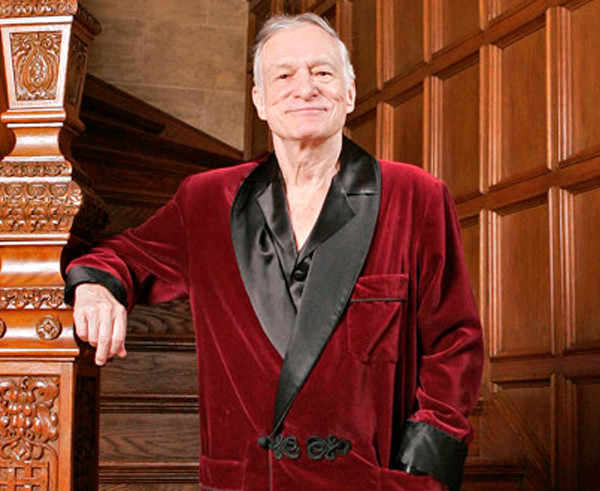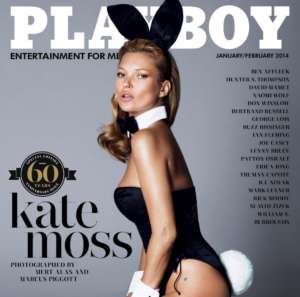
- “We’ve tried to turn on the lights!”
By NP Newsroom
LOS ANGELES: Hugh Hefner — the Playboy men’s magazine founder who popularized the term “centerfold — died at the age of 91 on Wednesday at the Playboy Mansion in Los Angeles.
Hefner was a catalyst to the sexual revolution of the 1960s and founded Playboy in 1953 with $600 of his own money, eventually making the magazine into a multimillion-dollar entertainment empire that included TV shows, a jazz festival and a string of Playboy Clubs whose cocktail waitresses wore bunny ears and cottontails.
A report by CNN says: Over the years, “the legend of ‘Hef’ only grew as he bedded hundreds of young women, married a few of his magazine’s ‘Playmates’ and cavorted on reality TV shows with a stable of girlfriends less than a third his age. Some critics dismissed him as a relic of a sexist era, especially in his later years, when Hefner spoke openly of his Viagra-fueled sex romps at the Playboy Mansion. But many men envied his boyish, devil-may-care lifestyle.

“His pioneering magazine, his biggest legacy, may have helped the buttoned-up America of the 1950s and early 1960s loosen up a little about sex,” the channel says, quoting Hefner as saying, “I would like to be remembered as somebody who has changed the world in some positive way, in a social, sexual sense, and I’d be very happy with that. I’m a kid who dreamed the dreams and made them come true.”
Hugh Hefner was born on April 9, 1926, in Chicago to accountant Glenn Hefner teacher Grace Hefner. Both parents were conservative Protestants from Nebraska. He says his parents were raised pure prohibitionist and that they were very good people, with high moral standards but very repressed. “There was no hugging and kissing in my home,” Hefner said in one interview to The Hollywood Reporter paper.
Hefner graduated from high school in 1944 and joined the U.S. Army as a writer for a military newspaper. In the wake of World War II he became a promotional copywriter at Esquire magazine.
“Esquire was always for older guys, but … it was very much devoted to male bonding and outdoor adventure,” Hefner told CNN. “And I wanted to read a magazine that was a little more sophisticated and was focused really on the romantic connection between the sexes from a male point of view.”
After raising $10,000 from investors, Hefner published the debut issue of Playboy in December 1953. The premiere issue had no date, in case it sold poorly and there wasn’t a second issue. On its cover was actress Marilyn Monroe, who also appeared in a nude centerfold. Playboy was an immediate success, selling more than 50,000 copies.
Hefner helped personally select monthly “Playmates,” persuaded famous sex symbols such as Jayne Mansfield and Ursula Andress to pose nude for the magazine and coined the term “centerfold”. He was arrested in 1963 on charges that Playboy violated obscenity laws, but a jury acquitted him after a trial.
But Playboy’s portrayal of women also drew a backlash. However Hefner said Playboy was about celebrating sexuality. “I think that women, in the best sense, and not in a negative sense, are objects of desire,” he said on Larry King Live in 2010. “That is a celebration of one’s own sexuality and the fact that we are two sexes.”
But the magazine wasn’t just about sex. Playboy published articles and short fiction by some of the most celebrated writers of the day including Ian Fleming, John Updike and Vladimir Nabokov, inadvertently creating a joke phrase, “I only read Playboy for the articles.”
The magazine also earned respect for tackling social issues and carrying lengthy interviews with high-profile figures like Martin Luther King Jr., John Lennon and Muhammad Ali. “I knew I could do the other half of what I’m really all about, which is social justice,” Hefner told King. “It wasn’t simply race. It had to do with sexual prejudice and it had to do with drug prejudice.”
CNN says: His civil rights advocacy was chronicled in a 2009 documentary titled “Hugh Hefner: Playboy, Activist, Rebel.”
Jimmy Carter made headlines after granting Playboy an interview during his 1976 campaign for president. “I have looked on a lot of women with lust,” Carter told the magazine, startling many readers. “I’ve committed adultery in my heart many times. God recognizes I will do this and forgives me.”
Hefner steadily expanded his Playboy brand in the 60s hosting TV shows “Playboy’s Penthouse” and “Playboy After Dark”, that featured him chatting up entertainers in a swinging, bachelor-party setting.
In 1960, he launched a chain of exclusive Playboy Clubs in cities across the U.S. and abroad. And in 1971, he bought the now famous Playboy Mansion in Los Angeles, which soon became Hefner’s home and attracted celebrities to its lavish all-night parties.
Playboy went public in 1971, the same year the magazine’s monthly circulation peaked at 7 million issues, CNN says. But Hefner’s empire soon found itself grasping to define its role in a post-sexual revolution, post-feminist world. Raunchier men’s magazines such as Penthouse and Hustler siphoned off readers. By the 1980s Playboy had lost much of its appeal.
After Hefner suffered a minor stroke in 1985, he stepped down as CEO and turned over all Playboy business operations to his daughter, Christie. In 1989, Hefner, who had divorced his first wife Millie 30 years earlier, married Kimberly Conrad, a 26-year-old former Playmate of the Year with whom he fathered two boys. The couple separated in 1998 and eventually divorced.
By the 2000s, the rise of internet pornography and “lad mags” such as Maxim, which featured scantily clad starlets, had eroded much of Playboy’s subscriber base. But Hefner’s own profile grew again thanks to “The Girls Next Door,” a reality TV series about his life with three of his young blonde girlfriends. The show ran for five years on E!
Through it all, Hefner kept up a weekly schedule of rather tame activities at the Mansion — including a movie night, a game night and his prolific scrapbooking hobby — with a dwindling cadre of Old Hollywood buddies. In December 2012, after dating on and off for several years, Hefner married Crystal Harris, another former Playmate, in a small private ceremony at the Playboy Mansion. He was 86; she was 26.
In 2013 in an interview with Esquire magazine Hefner said the number of women he had slept with was “over a thousand, I’m sure.”
“There were chunks of my life when I was married, and when I was married I never cheated. But I made up for it when I wasn’t married,” he told the magazine.A peek at Playboy’s new non-nude magazine
By late 2015, Playboy’s circulation was down to about 800,000, and the company announced that it was surrendering to the realities of the internet, where every sexual fetish is catered to. But it reneged, describing it as a mistake.
In 2016, even the Playboy Mansion sold for about $100 million — half of Hugh Hefner’s asking price — with a caveat that Hefner coul live there for the remainder of his life.
In recent years, Playboy has made most of its money from licensing its brand and familiar rabbit logo around the world for fragrances, jewelry and other products.
But Hefner holds a Guinness World Record for the longest career as an editor-in-chief for the same magazine, more than 60 years, and his persona has left an indelible mark on cultures the world over.
Hefner has said: “If you don’t encourage healthy sexual expression in public, you get unhealthy sexual expression in private,” his magazine quoted him as saying in 1974. “If you attempt to suppress sex in books, magazines, movies and even everyday conversation, you aren’t helping to make sex more private, just more hidden. You’re keeping sex in the dark. What we’ve tried to do is turn on the lights.”






